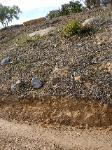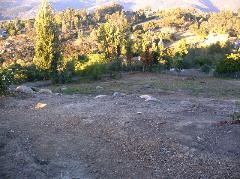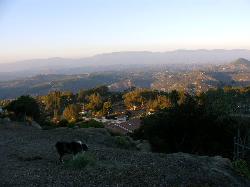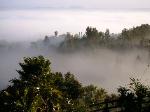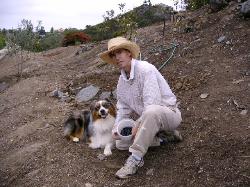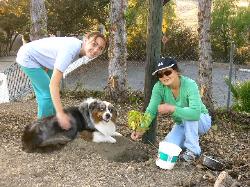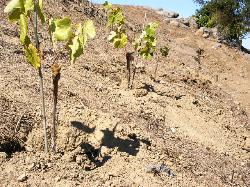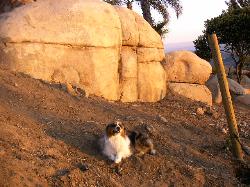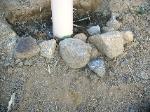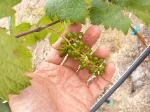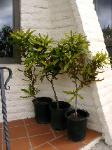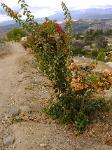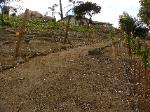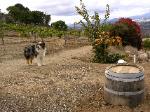
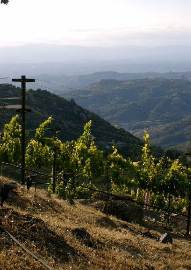
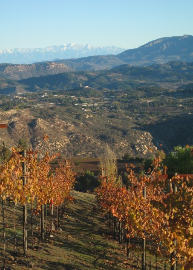

Grenache vines on western slope with
views to the Pacific Ocean & Big Bear.
views to the Pacific Ocean & Big Bear.
Zinfandel vines after April rain.
View of Aglianico vines in early January.
| Here's How It Looked After We Cleared The Land Before Planting |
| Our varietals: |
(March 11, 2007 -- Summer arrived early
this year, along with Daylight Savings
Time. The afternoon temperatures
climbed to 93 in the Valley today, and
reached the high 80s on the
mountainside at the Blue Merle. It's a
good thing we've selected vines that can
take the heat! Here's what we're planting:
(Information provided by
wine.appellationamerica.com with
commentary by the author.)
Grenache Noire
Grenache-based wines tend to be high in
alcohol, with attractive fruit qualities in youth.
The grape is most often found playing a
supporting role in blended wines -- but can
stand on its own as well. Throughout the
Mediterranean and California, Grenache is
partnered with a long list of varietals, including
Tempranillo, Syrah, Mourvèdre, Carignan and
Cinsault. Its strength is its ability to grow in arid
and windy conditions (such as those found at
the Blue Merle), make it well suited to the
warm coastal regions of California, Spain and
France. It is the most planted grape in Spain,
where it is known as Garnacha. When blended
with Tempranillo in Rioja, Garnacha can
provide the wines of the region with body and
alcoholic strength. In France, it is extensively
grown in the Southern Rhône, Provence and
Languedoc-Roussillon. It is a component of
almost every appellation in the south. In the
Southern Rhône, it partners with the more
tannic Syrah, to add youthful fruit and alcohol
to Côtes de Rhône wines. Its ability to
withstand the bluster of the Mistral wind permits
it to grow easily in the Rhône ' s most famous
appellation, Chateneuf de Pape. We have
planted 120 vines.
Aglianico
Along with Sangiovese and Nebbiolo,
Aglianico is considered one of Italy ' s three
noble grape varietals. Until very recently,
Aglianico has been overlooked by the
international wine buying public. However, a
renewed interest and investment in south
Italian wines has brought a new level of
recognition to Aglianico. The wines
themselves are extremely high in both tannins
and acidity. Often closed in youth, with time,
Aglianico develops rich game, earth and dark
fruit qualities. In Taurasi, the wines must be
aged for a minimum of three years before
release and are allowed up to 15 percent of
other grapes, such as Piedierosso and
increasingly Merlot in order to soften the
wine's rougher edges. We have planted 180
vines.
Tempranillo
Fittingly, Spain 's most noble red grape variety
is finally making inroads in the American state
with the richest Spanish heritage - California.
Famous in Spain ' s Rioja region, Tempranillo
now graces some of the premium-quality,
grape-growing regions of California (such as
Napa Valley and Blue-Merle Country) and is
making its mark as a varietal. The
thick-skinned, productive Tempranillo can
produce dry, scented, age-worthy wines that
are deep-hued and not too high in alcohol.
Used in the best quality red wines throughout
Spain. Large acreages of Tempranillo are also
found in Argentina. One major drawback of the
variety is its fairly low acidity. The musts tend
to have an excessively high pH level and
roughly half of their total acidity is malic,
meaning that varietally-made Tempranillo
should retain its color well, but lose its fruit and
liveliness after a few years. Hence the
tendency for winemakers to throw varying
proportions of other grapes into the blend to
make-up for this shortcoming of an otherwise
noble cepage. We have planted 260 vines.
Petite Sirah
Developed in the 1870s in France> ' s Rhône
region to resist Powdery Mildew to which Syrah
is susceptible. Although mildew-resistant, the
tightly-bunched variety was vulnerable to gray
rot in the humid southern Rhône. Fortunately,
the grape has adapted well to the drier
climates of California, and to those of
northeastern Victoria, in Australia. In fact, the
grape has succeeded better abroad than in its
south of France birthplace, where it is now
almost extinct. Its small berries, and
consequently high skin-to-juice ratio, allow
Petite Sirah to produce wines with high tannin
levels, surprisingly high acidity, and thus the
ability to age. Characteristically, these wines
have dense blackberry fruit character, mixed
with black pepper notes. This variety has the
ability to create rich, age worthy reds and is
reestablishing itself as one of California's great
grapes. (We have planted over 150 vines.)
Zinfandel has delivered not only zesty,
berry-fruity reds, but spicy tannic beasts, vin
nouveau, and tart, intriguing roses. There have
also been soft, simple and sweet blushes,
unusual sparklers, dessert and fortified wines,
and nearly combustible, highly-alcoholic
versions. Zinfandel has always found ways to
remain useful and to maintain its plantings in
California, even as fickle consumer tastes
bounce from one style to the next. Most have
crowned Cabernet Sauvignon as King in
California. However, Zinfandel is the only red
varietal that comes close to Cabernet in total
acreage and volume of fruit crushed.
Fortunately, Zinfandel has finally become
trendy, and after years of playing second
fiddle, it is taking much of the spotlight. (250
vines.)
this year, along with Daylight Savings
Time. The afternoon temperatures
climbed to 93 in the Valley today, and
reached the high 80s on the
mountainside at the Blue Merle. It's a
good thing we've selected vines that can
take the heat! Here's what we're planting:
(Information provided by
wine.appellationamerica.com with
commentary by the author.)
Grenache Noire
Grenache-based wines tend to be high in
alcohol, with attractive fruit qualities in youth.
The grape is most often found playing a
supporting role in blended wines -- but can
stand on its own as well. Throughout the
Mediterranean and California, Grenache is
partnered with a long list of varietals, including
Tempranillo, Syrah, Mourvèdre, Carignan and
Cinsault. Its strength is its ability to grow in arid
and windy conditions (such as those found at
the Blue Merle), make it well suited to the
warm coastal regions of California, Spain and
France. It is the most planted grape in Spain,
where it is known as Garnacha. When blended
with Tempranillo in Rioja, Garnacha can
provide the wines of the region with body and
alcoholic strength. In France, it is extensively
grown in the Southern Rhône, Provence and
Languedoc-Roussillon. It is a component of
almost every appellation in the south. In the
Southern Rhône, it partners with the more
tannic Syrah, to add youthful fruit and alcohol
to Côtes de Rhône wines. Its ability to
withstand the bluster of the Mistral wind permits
it to grow easily in the Rhône ' s most famous
appellation, Chateneuf de Pape. We have
planted 120 vines.
Aglianico
Along with Sangiovese and Nebbiolo,
Aglianico is considered one of Italy ' s three
noble grape varietals. Until very recently,
Aglianico has been overlooked by the
international wine buying public. However, a
renewed interest and investment in south
Italian wines has brought a new level of
recognition to Aglianico. The wines
themselves are extremely high in both tannins
and acidity. Often closed in youth, with time,
Aglianico develops rich game, earth and dark
fruit qualities. In Taurasi, the wines must be
aged for a minimum of three years before
release and are allowed up to 15 percent of
other grapes, such as Piedierosso and
increasingly Merlot in order to soften the
wine's rougher edges. We have planted 180
vines.
Tempranillo
Fittingly, Spain 's most noble red grape variety
is finally making inroads in the American state
with the richest Spanish heritage - California.
Famous in Spain ' s Rioja region, Tempranillo
now graces some of the premium-quality,
grape-growing regions of California (such as
Napa Valley and Blue-Merle Country) and is
making its mark as a varietal. The
thick-skinned, productive Tempranillo can
produce dry, scented, age-worthy wines that
are deep-hued and not too high in alcohol.
Used in the best quality red wines throughout
Spain. Large acreages of Tempranillo are also
found in Argentina. One major drawback of the
variety is its fairly low acidity. The musts tend
to have an excessively high pH level and
roughly half of their total acidity is malic,
meaning that varietally-made Tempranillo
should retain its color well, but lose its fruit and
liveliness after a few years. Hence the
tendency for winemakers to throw varying
proportions of other grapes into the blend to
make-up for this shortcoming of an otherwise
noble cepage. We have planted 260 vines.
Petite Sirah
Developed in the 1870s in France> ' s Rhône
region to resist Powdery Mildew to which Syrah
is susceptible. Although mildew-resistant, the
tightly-bunched variety was vulnerable to gray
rot in the humid southern Rhône. Fortunately,
the grape has adapted well to the drier
climates of California, and to those of
northeastern Victoria, in Australia. In fact, the
grape has succeeded better abroad than in its
south of France birthplace, where it is now
almost extinct. Its small berries, and
consequently high skin-to-juice ratio, allow
Petite Sirah to produce wines with high tannin
levels, surprisingly high acidity, and thus the
ability to age. Characteristically, these wines
have dense blackberry fruit character, mixed
with black pepper notes. This variety has the
ability to create rich, age worthy reds and is
reestablishing itself as one of California's great
grapes. (We have planted over 150 vines.)
Zinfandel has delivered not only zesty,
berry-fruity reds, but spicy tannic beasts, vin
nouveau, and tart, intriguing roses. There have
also been soft, simple and sweet blushes,
unusual sparklers, dessert and fortified wines,
and nearly combustible, highly-alcoholic
versions. Zinfandel has always found ways to
remain useful and to maintain its plantings in
California, even as fickle consumer tastes
bounce from one style to the next. Most have
crowned Cabernet Sauvignon as King in
California. However, Zinfandel is the only red
varietal that comes close to Cabernet in total
acreage and volume of fruit crushed.
Fortunately, Zinfandel has finally become
trendy, and after years of playing second
fiddle, it is taking much of the spotlight. (250
vines.)
Surveying the scene from 1,650 ft. above sea
level from "Bobcat Ridge" near the spot of the first
Bobcat sighting, before planting.
level from "Bobcat Ridge" near the spot of the first
Bobcat sighting, before planting.
Kevin clears a path with his
dozer.
dozer.
Guest house at the "Top of the
Hill," future home of Aglianico.
Hill," future home of Aglianico.
February 22, 2007 -- After 9
months of preparation,
D-Day (Digging Day)
operations will soon begin
and our baby will be born.
The end posts were
delivered today. Next week,
we'll dig the holes for
them. Then the supporting
stakes for the trellis
system. Then the wires.
Then the irrgiation. If all
goes well, over 700 plants
from Novavines will be in
the ground by March's
end. We've chosen
varietals that can take the
heat: Tempranillo, Petite
Syrah, Grenache,
Zinfandel and Aglianico.
To frame our work of art,
we've planted Merlot
"cuttings" from our
neighbor's vineyard along
the fence, naming that
area "Fence de Lum" in
honor of the Master. The
pictures below show the
land before and during
preparation, with the
ceremonial planting of the
first vine last summer. At
times, we're blessed with
a rainbow. At others, it's as
if we're on the Chinese
mountain of Hwang Shan
surrounded by fog, hidden
dragons, couching tigers
(well, at least Bobcats and
snakes).
months of preparation,
D-Day (Digging Day)
operations will soon begin
and our baby will be born.
The end posts were
delivered today. Next week,
we'll dig the holes for
them. Then the supporting
stakes for the trellis
system. Then the wires.
Then the irrgiation. If all
goes well, over 700 plants
from Novavines will be in
the ground by March's
end. We've chosen
varietals that can take the
heat: Tempranillo, Petite
Syrah, Grenache,
Zinfandel and Aglianico.
To frame our work of art,
we've planted Merlot
"cuttings" from our
neighbor's vineyard along
the fence, naming that
area "Fence de Lum" in
honor of the Master. The
pictures below show the
land before and during
preparation, with the
ceremonial planting of the
first vine last summer. At
times, we're blessed with
a rainbow. At others, it's as
if we're on the Chinese
mountain of Hwang Shan
surrounded by fog, hidden
dragons, couching tigers
(well, at least Bobcats and
snakes).
View from top looking down. We face a steep slope
and will plant following the land (in hopes of
keeping the soil on the mountain).
and will plant following the land (in hopes of
keeping the soil on the mountain).
The Blue Merle on gopher patrol. This hilltop is the
site of the first rattle snake sighting. As we cleared the
land in June 2006, we flushed out six snakes in a two
week period. The seventh one got away. Two that
stayed behind met their match in December, as they
slumbered under a pile of tiles by the shed. We've
only come across 3 rattles in 2007, and possibly one
King Snake (a god guy!)
site of the first rattle snake sighting. As we cleared the
land in June 2006, we flushed out six snakes in a two
week period. The seventh one got away. Two that
stayed behind met their match in December, as they
slumbered under a pile of tiles by the shed. We've
only come across 3 rattles in 2007, and possibly one
King Snake (a god guy!)
Rainbow sunrise.
Poplar trees provide wind protection.
Foggy sunrise.
Fruits from first olive harvest. October 15, 2006.
Craig Justice, Olive Farmer.
Craig Justice, Olive Farmer.
The princess and [homecoming] Queen Mother
plant the first vine in August, 2006 supervised
by Bluey. This is a prologue to "The Big Dig" in
2007.
plant the first vine in August, 2006 supervised
by Bluey. This is a prologue to "The Big Dig" in
2007.
The mysterious "Man In The Rock"
by day. At night, under
illumination from a soft solar light,
the face of an Indian chief -- or is it
a ghost? -- magically appears.
Right below the rock, incredibly,
the remnants of a 25-year old kiwi
tree are discovered, alive, from
the original kiwi grove! Beware
the powers of the rock....(Editor's
note: the kiwi succumbed to a
gopher, who declared war against
the Blue Merle with that vicious
act.
by day. At night, under
illumination from a soft solar light,
the face of an Indian chief -- or is it
a ghost? -- magically appears.
Right below the rock, incredibly,
the remnants of a 25-year old kiwi
tree are discovered, alive, from
the original kiwi grove! Beware
the powers of the rock....(Editor's
note: the kiwi succumbed to a
gopher, who declared war against
the Blue Merle with that vicious
act.
First row of vines, August 2006. Vines courtesy of
Coyote Oaks Vineyard, Karen Sherman. Without
irrigation and rabbit protectors, the vines made it
to 2007. This row demonstrates our method of
"Free Range Vines" without a trellis system,
allowing the vine to grow more naturally, in
nature. Organic fertilizer is provided daily by
Bluey.
Coyote Oaks Vineyard, Karen Sherman. Without
irrigation and rabbit protectors, the vines made it
to 2007. This row demonstrates our method of
"Free Range Vines" without a trellis system,
allowing the vine to grow more naturally, in
nature. Organic fertilizer is provided daily by
Bluey.
| After planting. The first summer. |
Granite rocks are placed
around each vine to control
erosion on the hillside, and to
keep water from flowing
downhill during watering.
around each vine to control
erosion on the hillside, and to
keep water from flowing
downhill during watering.
Bluey supervises thinning and training of the
vines at sunrise in June. Whale rock and her
baby are in the background.
vines at sunrise in June. Whale rock and her
baby are in the background.
Full moon rising over the vines at
midsummer, 2007.
midsummer, 2007.
The beginnings of a retaining
wall on Bobcat Ridge, home of
"Grandpa's Old Zinfandel."
wall on Bobcat Ridge, home of
"Grandpa's Old Zinfandel."
Pulling out extra shoots, to
encourage growth on one,
main shoot. The young vines
snap off with the fingers.
encourage growth on one,
main shoot. The young vines
snap off with the fingers.
| Training 1st year vine to the pole with flexible green tape. This ends up being more work than planting! Did you ever attend a "taping" party? |
Removing the tube
reveals multiple vines
growing. The main
vine is selected, and
the others are
discarded.
reveals multiple vines
growing. The main
vine is selected, and
the others are
discarded.
| Taping vine to the pole, so it will grow straight, or at least more straight. At 5 or so minutes per vine (pull off the tube, pull out the "sucker" vines, put rocks around the vine, tie the vine up, put the tub back on) -- this is a long process with 850+ vines! |

2-year old olive tree shows
good progress.
good progress.
Cross was part of the
original kiwi farm planted
25 years ago. White
Kennedy rose was gift
from Gunvor & John.
When we purchased the
property, the cross was
buried under a forest of
ivy Ents -- we didn't know
it was there until we
cleared the land.
original kiwi farm planted
25 years ago. White
Kennedy rose was gift
from Gunvor & John.
When we purchased the
property, the cross was
buried under a forest of
ivy Ents -- we didn't know
it was there until we
cleared the land.
Avocado of uncertain
age has been nursed
back to health.
age has been nursed
back to health.
Still plenty of work to be done!

Bluey keeps an eye
out for birds just
before the first
harvest of the
Grenache vines in
September 2009.
The harvest yielded
1,200 lbs. of
Tempranillo, 500 lbs
of Zinfandel, 400 lbs.
of Petit Sirah and
200 lbs. of
Grenache. See more
photos and stay in
touch on our
Facebook page.
out for birds just
before the first
harvest of the
Grenache vines in
September 2009.
The harvest yielded
1,200 lbs. of
Tempranillo, 500 lbs
of Zinfandel, 400 lbs.
of Petit Sirah and
200 lbs. of
Grenache. See more
photos and stay in
touch on our
Facebook page.
Follow Our Adventures!
| First day of autumn, of the first year (Sept., 2007) |
The Lavender Fields
at Blue-Merle
Vineyard overlook
the Pacific Ocean at
an elevation of 1,600
ft. On the left is baby
Provence Lavender;
the right row is baby
Spanish Lavender.
at Blue-Merle
Vineyard overlook
the Pacific Ocean at
an elevation of 1,600
ft. On the left is baby
Provence Lavender;
the right row is baby
Spanish Lavender.
 |


